| 1 | A. Forewing venation greatly reduced; RS absent and crossvein r present only as a short stub; Neotropical, rare. | Mesocoelus |
| – | B. Forewing venation moderately reduced; apical abscissa of RS absent, or mostly so, but crossvein r complete to junction of RS; Neotropical, rare. | 2 |
| – | C. Forewing venation not significantly reduced; apical abscissa of RS complete or almost complete to wing margin; widespread, common. | 4 |

| ||
| 2(1) | A. Hind wing subbasal (SB) cell 4-sided with vein Cub emanating from an angle in the cell AND/OR AA. Posterior surface of scutellum with a semi-circular or arc-shaped depression (post-scutellar depression) | Therophilus (in part) |
| – | B. Hind wing subbasal (SB) cell 3-sided. If Cub vein is present, it emanates from a straight vein. BB. Post scutellar depression absent, but rugose sculpture usually present. | 3 |
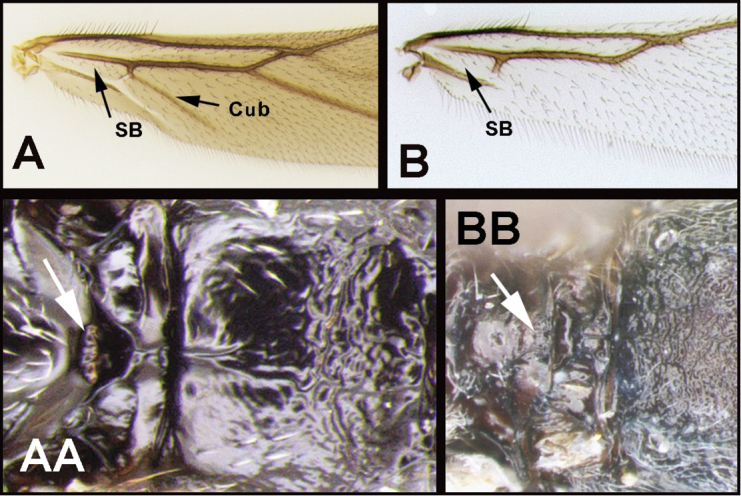
| ||
| 3(2) | A. Median area of first tergum not raised above lateral portions and granulate or striogranulate. AA. Hind coxal cavities (HCC) open to metasomal foramen or narrowly closed and positioned partly above ventral margin of metasomal foramen (MF); ventral margin of metasomal foramen lacking a straight transverse carina | Plesiocoelus |
| – | B. Median area of first tergum raised above lateral portions, sculpture variable but often smooth or smoothly striate. BB. Hind coxal cavities closed and positioned completely below the metasomal foramen; ventral margin of metasomal foramen with a strong, relatively straight transverse carina (TC) | Aerophilus (in part) |

| ||
| 4(1) | A. Fore tarsal claws bifid | 5 |
| – | B. Fore tarsal claws simple, with distinct basal lobe. | 9 |
| – | C. Fore tarsal claws simple, lacking a distinct basal lobe. | 31 |

| ||
| 5 | A. Forewing areolet quadrate, not or only slightly narrower anteriorly. AA. Ovipositor as long as or longer than half the length of metasoma | 7 |
| – | B. Forewing areolet triangular, or if quadrate much narrower anteriorly. BB. Ovipositor shorter than half the length of metasoma. | 6 |

| ||
| 6(5) | A. Gena expanded into a flange posteriorly; malar space (MS) more than ½ length of eye height (EH); Neotropical, rare | Hemichoma |
| – | B. Gena not modified into a flange posteriorly; malar space (MS) less than ½ length of eye height (EH); widespread, common | Zelomorpha |
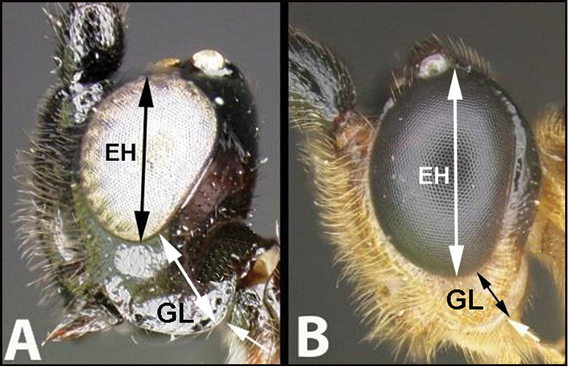
| ||
| 7(5) | A. Body predominantly orange/yellow. AA. Frons bordered by a carina posteriorly; widespread, common | 8 |
| – | B. Body predominantly black. BB. Frons not bordered by a carina posteriorly; southern USA through the tropical Neotropics, uncommon | Zacremnops |

| ||
| 8(7) | A. Propodeum and hind coxa with granulate sculpture; first metasomal tergum ca. 3 × wider at apex than at base; rare; Neotropical, rare | Labagathis |
| – | B. Propodeum and hind coxa lacking granulate sculpture; first metasomal tergum not ca. 2 × wider at apex than at base; widespread, relatively common | Cremnops |

| ||
| 9(4) | A. Notauli present | 10 |
| – | B. Notauli absent | 25 |

| ||
| 10(9) | A. Ventral margin of clypeus projecting; width of temple longer than width of eye in lateral view; Nearctic, rare | Gelastagathis |
| – | B. Ventral margin of clypeus not projecting; width of temple shorter than width of eye in lateral view; widespread, common | 11 |
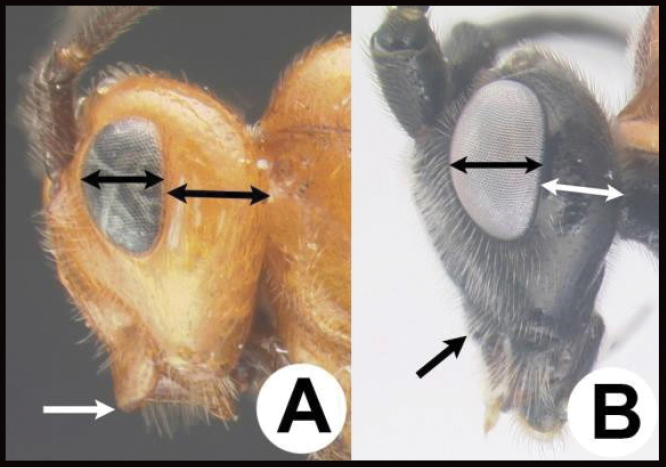
| ||
| 11(10) | A. Frons bordered by carinae or grooves posteriorly. | 12 |
| – | B. Frons not bordered by carinae or grooves posteriorly. | 14 |

| ||
| 12(11) | A. Hind coxa with granulate sculpture. AA. Second submarginal cell minute or absent; Neotropical, rare | Trachagathis |
| – | B. Hind coxa smooth, lacking granulate sculpture. BB. Second submarginal cell of normal dimensions; widespread, common. | 13 |

| ||
| 13(12) | A. First metasomal tergum smooth with two widely spaced converging carinae forming a teardrop-shaped basal area; Neotropical, rare | Pharpa |
| – | B. First metasomal tergum usually smooth and convex, or BB. With a median longitudinal carina, or, BBB. Rarely with 2 carinae, in which case the tergum has more extensive sculpture; widespread, common | Alabagrus |

| ||
| 14(11) | A. Malar space (MS) distinctly greater than ½ eye height (EH); head shape in frontal view elongate, at least as high (measured from ventral margin of clypeus) as wide. | 15 |
| – | B. Malar space USUALLY (95%) equal to or less than ½ eye height; head shape in frontal view wide, wider than high (measured from ventral margin of clypeus) | 16 |
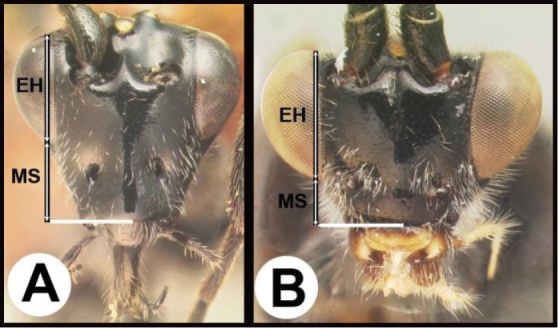
| ||
| 15(14) | A. Third tergum completely smooth; pair of carinae on first tergum not prominent. AA. Hind coxal cavities (HCC) open to metasomal foramen or narrowly closed and positioned partly above ventral margin of metasomal foramen (MF); common in Nearctic, very rare in Neotropics | Agathis (in part) |
| – | B. Third tergum usually (95%) partly or completely sculptured, sculpture often confined to narrow line along transverse depression; pair of carinae on first tergum prominent. BB. Hind coxal cavities closed and positioned completely below the metasomal foramen; ventral margin of metasomal foramen with a strong, relatively straight transverse carina (TC); widespread, common | Aerophilus (in part) |

| ||
| 16(14) | A. Propodeal spiracle elongate, more than 2 × longer than wide; widespread, common | Pneumagathis |
| – | B. Propodeal spiracle circular or ovoid, not more than 2 × longer than wide | 17 |
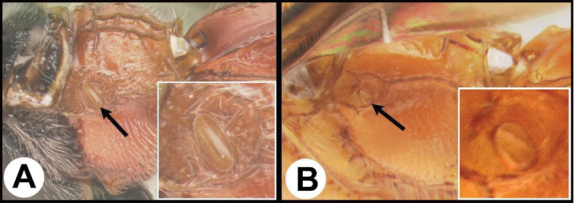
| ||
| 17(16) | A. Pair of carinae on first tergum NOT prominent. AA. Hind coxal cavities (HCC) open to metasomal foramen or narrowly closed and positioned partly above ventral margin of metasomal foramen (MF). | 18 |
| – | B. Pair of carinae on first tergum prominent; BB. Hind coxal cavities closed and positioned below the metasomal foramen; ventral margin of metasomal foramen with a strong, relatively straight transverse carina (TC); widespread, common | Aerophilus (in part) |

| ||
| 18(17) | A. First tergum completely smooth, or rarely with some punctures posterolaterally | 20 |
| – | B. First tergum with sculpture | 19 |

| ||
| 19(18) | A. Vein Cub of hind wing long and partly tubular, apical margin of subbasal (SB) cell angled; widespread, common. | Therophilus (in part) |
| – | B. Vein Cub of hind wing weak or absent and never tubular; apical margin of subbasal cell (SB) straight. Nearctic and northern Neotropics (i.e., Mexico and Central America), much less common | Agathirsia (in part) |

| ||
| 20(18) | A. Notauli pitted or crenulate | 21 |
| – | B. Notauli smooth | 24 |

| ||
| 21(20) | A. Third tergum usually entirely smooth or weakly and partly coriarious (leather-like), if with different sculpture (especially in transverse depressions), then pair of longitudinal carinae on first metasomal tergum weaker than in B or absent. AA. Hind coxal cavities (HCC) open to metasomal foramen or narrowly closed and positioned partly above ventral margin of metasomal foramen (MF) | 22 |
| – | B. Third tergum usually partly or completely sculptured, sculpture often confined to narrow line along transverse depression; pair of longitudinal carinae on first metasomal tergum present and extending past spiracles. BB. Hind coxal cavities closed and positioned entirely below the metasomal foramen (MF); ventral margin of metasomal foramen with a strong, relatively straight transverse carina (TC); widespread, common | Aerophilus (in part). |

| ||
| 22(21) | A. First tergum partly or completely granulate; widespread, common | Neothlipsis |
| – | B. First tergum otherwise sculptured, usually striate or rugostriate. | 23 |
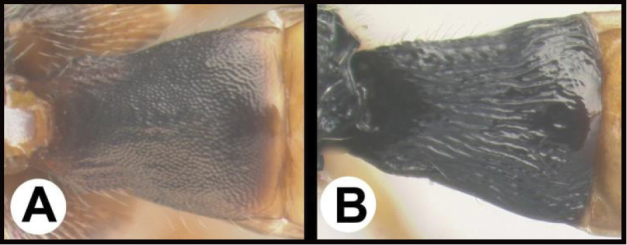
| ||
| 23(22) | A. Posterior apex of scutellum with a distinct depression in the form of a semicircle or two distinct pits; widespread, common. | Therophilus (in part) |
| – | B. Posterior apex of scutellum lacking depression, smooth to rugose; common in Nearctic, very rare in Neotropics. | Agathis (in part) |

| ||
| 24(20) | A. Propleuron with a distinct protuberance; gena expanded into an acute angle posteroventrally; Neotropical, rare | Zamicrodus |
| – | B. Propleuron flat or weakly convex, lacking a distinct protuberance; genae not expanded and rounded posteroventrally; Neotropical, rare | Aphelagathis |
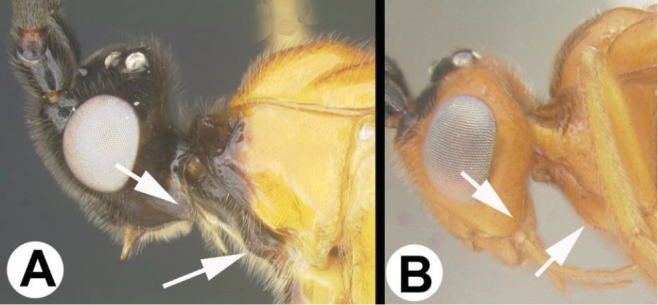
| ||
| 25(9) | A. Second submarginal cell of forewing quadrate. AA. Cub vein of hind wing present and often tubular; subbasal cell angled distally at junction of Cub; Chile and southern Argentina (Note: Unlike the better known north temperate group of Earinus, members of this assemblage are found only in southern and high-altitude South America, and may deserve separate generic status), common | Earinus (in part) |
| – | B. Not combining the above character states; second submarginal cell usually triangular. BB. Cub vein of hind wing usually absent or not tubular, and subbasal sell not angled distally. | 26 |

| ||
| 26(25) | A. Forewing vein RS+M present and complete, though sometimes weaker at midlength; Nearctic, common. | Earinus (in part) |
| – | B. Forewing vein RS+M completely or mostly absent | 27 |

| ||
| 27(26) | A. Third tergum completely smooth. AA. Hind coxal cavities (HCC) open to metasomal foramen (MF), or narrowly closed such that the ventral part of the metasomal foramen is below the dorsal margin of the hind coxal cavities | 28 |
| – | B. Third tergum usually (95% of specimens) partly or completely sculptured, sculpture often confined to narrow lines along transverse depressions. BB. Hind coxal cavities closed and positioned completely below the metasomal foramen; ventral margin of metasomal foramen with a strong, relatively straight transverse carina; widespread, common | Aerophilus (in part) |

| ||
| 28(27) | A. Spurious vein, RS2b, well-developed. AA. Ovipositor barely exerted, much shorter than metasoma. Neotropical, very rare | Marjoriella |
| – | B. Spurious vein, RS2b, lacking. BB. Ovipositor at least as long as metasoma. Widespread, common | 29 |

| ||
| 29(28) | A. Second submarginal cell smaller than its dorsal stem; apical abscissa of RS curving towards fore margin of wing; Neotropical, very rare | Smithagathis |
| – | B. Second submarginal cell larger than its dorsal stem; apical abscissa of RS straight | 30 |

| ||
| 30(29) | A. Posterolateral corner of gena sharp; propleuron with a protuberance; Neotropical, rare | Amputoearinus |
| – | B. Posterolateral corner of gena rounded; propleuron evenly convex, lacking a protuberance; widespread, common. | Lytopylus |
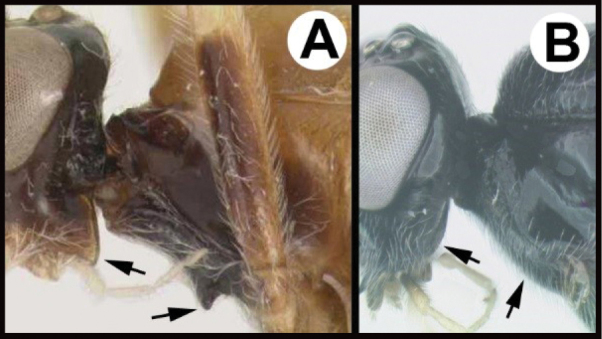
| ||
| 31(4) | A. Notauli absent, mesoscutum completely smooth; Neotropical, rare | Sesioctonus |
| – | B. Notauli present though sometimes only indicated anteriorly or posteriorly; widespread and common in Nearctic, rare in Neotropics. | 32 |
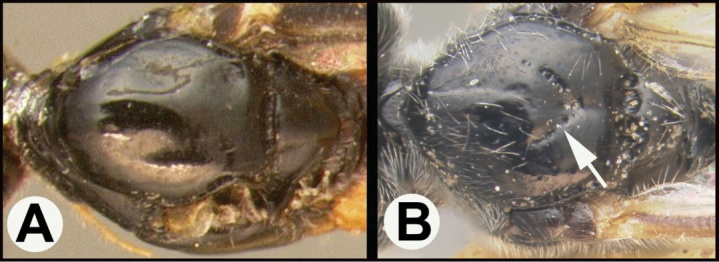
| ||
| 32(31) | A. First tergum smooth, lacking microsculpture, at most with punctures laterally; Nearctic and Central America, rare | 33 |
| – | B. First tergum with microsculpture, usually in the form of longitudinal striae or rugae; widespread and common in Nearctic, extremely rare in Neotropics | Agathis (in part) |
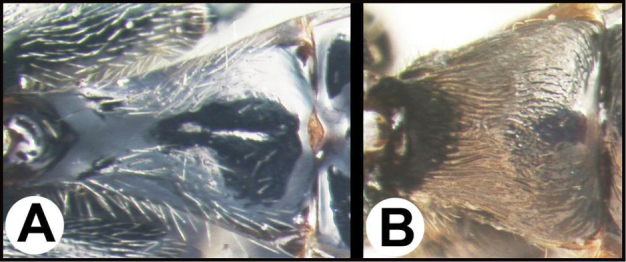
| ||
| 33(32) | A. Ovipositor barely exerted, shorter than half the length of metasoma; Nearctic and Central America (all species of Crassomicrodus key here) | Crassomicrodus |
| – | B. Ovipositor at least as long as half the metasoma, often much longer; Nearctic and Central America, rare (few species key here) | Agathirsia (in part) |

| ||

An official website of the United States government
Here's how you know
Official websites use .gov
A
.gov website belongs to an official
government organization in the United States.
Secure .gov websites use HTTPS
A lock (
) or https:// means you've safely
connected to the .gov website. Share sensitive
information only on official, secure websites.